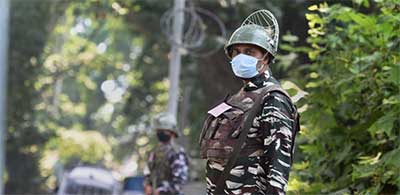Date : 11/07/2023
Relevance: GS Paper 3: security - militancy
Keywords: AFSPA, Line of Control, Kashmir Militancy
Context -
The Rajouri-Poonch region in Jammu and Kashmir has witnessed a resurgence in militancy, raising concerns about the security situation.
Militancy in Jammu Kashmir
- Militancy means using violence or aggressiveness, usually to support a cause
- Societies in conflict tend to reinforce the division between 'Us' and 'Them,' which is evident in Kashmir.
- The 1989 secessionist outbreak and subsequent government operations have intensified the 'Us vs. Them' narrative among Kashmiris, alienating them from the Indian polity.
- State actions include crackdowns, arrests, killings of local militants, and enforcement of laws like the PSA and AFSPA.
- Negative perceptions of India as a "colonizer" or "occupier" have been nurtured among Kashmiris
Government measures:
- Crackdowns, arrests, and targeted elimination of local militants.
- Implementation of laws such as PSA and AFSPA.
Impacts:
- Reinforcement of negative perceptions.
- View of the Indian state as a colonizer or occupier.
Recent developments
- Between 2014 and 2020, the region experienced a significant increase in local militancy and stone-pelting incidents. In response, the Indian armed forces launched 'Operation All Out' in 2017 to eliminate militant networks and top commanders. However, as most militants were locals, these operations further deepened the 'us vs. them' divide.
- The abrogation of Jammu and Kashmir's special status in 2019 raised concerns about increased terrorism-induced violence. However, the security situation has improved since then, with Doda being declared a terrorist-free district.
- As Jammu and Kashmir complete two years as a Union Territory, militancy remains a major challenge, especially with the Taliban takeover in Afghanistan potentially strengthening militant outfits like JeM and HuM.
- Moving forward, attention has shifted to District Development Councils (DDCs) and grassroots development as a means to address the political and governance issues. Social media has become a crucial source of information, but efforts to counter extremist content have been insufficient. Investing in AI and other technologies can help discourage the spread of extremist narratives.
- Additionally, focusing on education, including addressing historical distortions and promoting relatable and applicable themes, can contribute to long-term peace. Building narratives that bridge the divide between Kashmir and India is crucial, and the absence of armed conflict provides an opportunity to strengthen these efforts and bring lasting peace to the region.
Concerns Over the Revival of Militancy:
Increase in Terror-related Incidents:
- The Rajouri-Poonch region has experienced a relative surge in terror-related incidents in recent years.
- The attacks have resulted in the loss of lives, including security personnel, highlighting the need for effective counter-insurgency measures.
Changing Dynamics of Infiltration:
- Traditional infiltration routes through the Line of Control (LoC) have shifted, with some suggesting the use of alternative routes through Nepal and Bangladesh borders. This presents a challenge for security forces in preventing militant infiltration.
Factors Favoring Militants:
- Several factors, such as the use of smart technology, operations in small groups, and the reinvigoration of sleeper cells and over ground workers, have favored the militants.
- Additionally, the drug menace and its nexus with terrorism pose significant challenges.
Addressing the Challenges:
Importance of Local Support:
- The support of the local population, particularly the Gurjar-Bakkarwal community, has played a crucial role in countering militancy in the past.
- Efforts should be made to understand and address any grievances or alienation within the community.
Comprehensive Approach:
- Countering militancy requires a "whole of government" approach, recognizing that solutions are not obtained in isolation. It necessitates coordinated efforts in governance, justice, and security sectors to effectively address the multifarious challenges.
Socio-political Factors:
- Examining socio-political drivers, such as gaps in the implementation of the Forest Rights Act and tensions between Gurjar-Bakkarwals and Paharis over reservation issues, can help identify and address root causes of alienation.
Conclusion:
The resurgence of militancy in the Rajouri-Poonch region calls for urgent attention and comprehensive strategies. By engaging with the local population, particularly the Gurjar-Bakkarwals, and addressing socio-political issues, it is possible to overcome the challenges and restore peace in the region. A holistic approach that involves multiple sectors and stakeholders is essential in countering militancy and ensuring long-term stability.
Probable Questions for mains exam-
- What is militancy? Analysis of the underlying factors which are responsible for the rising of militancy in Jammu Kashmir. What steps have been taken by the Government to handle militancy? (10 Marks, 150 Words)
- Critically analyze the changing dynamics of infiltration, suggesting alternative routes by Nepal and Bangladesh border. How comprehensive measures can counter rising insurgency? (15 Marks, 250 Words)
Source The Hindu







